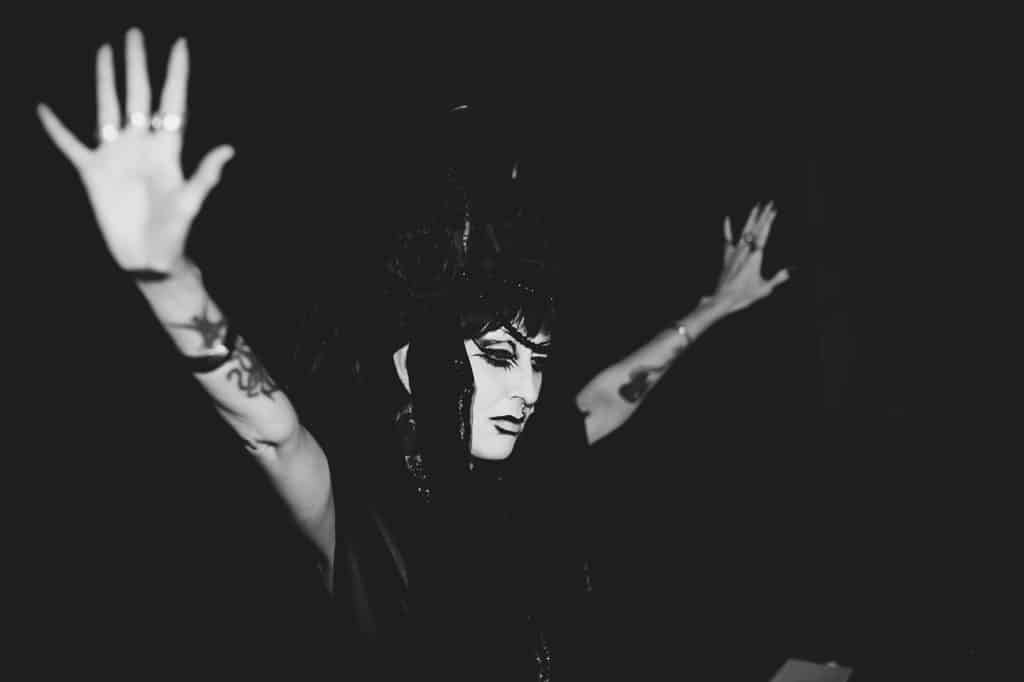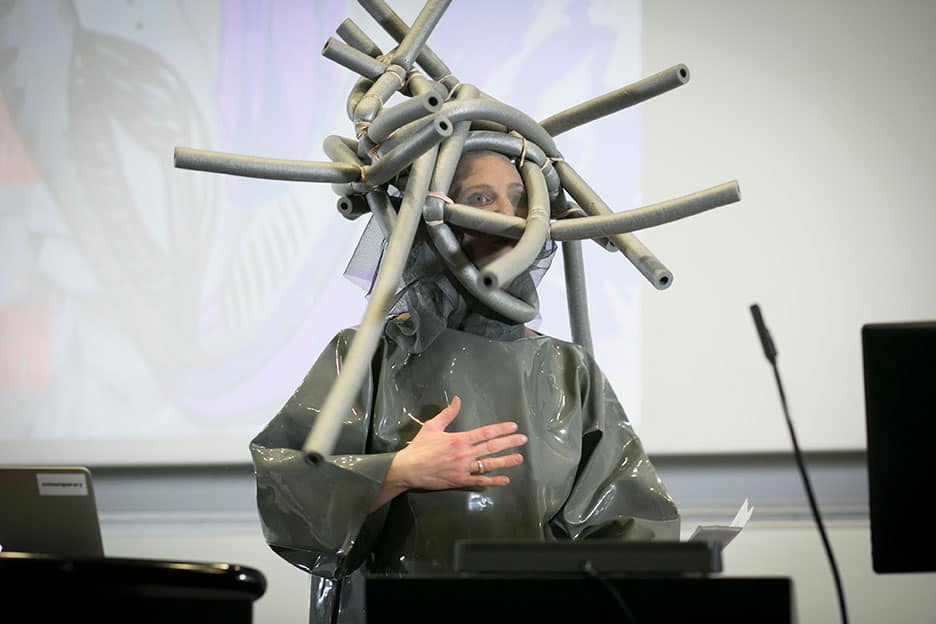Photo by Loredana Denicola. Courtesy Arts Feminism Queer.
What do we think of when we hear the words queer? LGBTQ activists have salvaged the transformative potential of the once derogatory term, rendering it into a force for agency and belonging. In academia, Eve Kosofsky Sedgwick, one of the seminal writers on queer theory, recalls “that “queer” can refer to: the open mesh of possibilities, gaps, overlaps, dissonances and resonances, lapses and excesses of meaning…” And how about queer in relation to live art? Giulia Casalini and Diana Georgiou, the founders of Cuntemporary – a not-for-profit collective championing feminist and queer art in the UK – define it as “live art which employs queer modes of inquiry… ‘queering’… is the alchemy of turning a white cube into a disco ball”. These queer modes of inquiry – camp, kitsch, tongue-in-cheek aesthetics generate new possibilities and meanings, which make it a fascinating form of art to engage with.
In fact interest in queer art has exploded in recent years; the most prominent example being this year’s widely publicised exhibition at the Tate titled ‘Queer British Art 1861-1967’ (Tate Britain, 5 April – 1 October 2017). This surge of intrigue has ricocheted beyond Western art institutions to Asia, where the Museum of Contemporary Art in Taipei hosted a recent blockbuster exhibition, ‘Spectrosynthesis: Asian LGBTQ Issues and Art Now’ (MOCA, 9 September – 5 November 2017), a timely mirror onto the current socio-political progression Taiwan is experiencing, as it steers on course to becoming the first Asian state to legalise same-sex partnerships. Queer aesthetics were also employed in Anne Imhof’s durational performance piece for the German Pavilion, this year’s Golden Lion award winner at the 57th Venice Biennale. In Faust, performers writhed and danced for extended lengths of time, reducing to their bodies to a state devoid of a clear sexuality, a subtle breaking away from heteronormativity, upsetting the nuclear family model, which the pillars of capitalism are so reliant upon.

Mette Sterre,Photo by Loredana Denicola. Courtesy Arts Feminism Queer.
I had the pleasure of witnessing first hand the political and transformative power of queer live art at Cuntemporary’s latest symposium, ‘Performing the Occult: Magick, Rituals and the Monstrous in Live Art’ and exhibition-cum-live art club night, Deep Trash, which took place in London last month. As the events fell in October, they were curated to channel the spirit of Halloween, with presentations and performances responding to themes of the occult, magick, and superstition.
The symposium was held at Queen Mary University, with five artists and academics delivering presentations on their chosen research area, followed by a Q&A discussion. I was particularly taken by Mette Sterre’s presentation, which defied the formality of an academic setting, instead opting to lead a marching cyborg raucous romp through the aisles of the lecture hall. Her troop crawled on the floor, agitated and convulsing, whilst Sterre orated a speech akin to Donna Haraway’s ‘A Cyborg Manifesto’, which froze the room with delight and confusion. Sterre is a London and Rotterdam based visual artist and designer, who creates phantasmagoric sculptural costumes which border the uncanny and the grotesque. Her performative lecture, ‘The haute-couture of non-human contour by Dr. Crystal Mette Sterre Frankenstein & the Fictions’ paid homage to Mary Shelly’s gothic classic and the fantastic potential of the human body. Donning a suitably outlandish persona of a trained DIY plastic surgeon and blood relative of the infamous Dokter Frankenstein, who went by the name Dr. Crystal Mette Sterre Frankenstein, Sterre’s unorthodox presentation was concerned with how far we can contort and skew the ‘natural’ human body in order to form a new form of ‘ethics’.

Patricia MacCormack, Photo by Loredana Denicola. Courtesy Arts Feminism Queer.
Utilising her DIY prosthetics – costumes made of tubular rubber pipes, swathes of golden baking foil fashioned into an opulent cloak, clumps of plastic white tinsel congealed together hardening a shell on a four-legged human-animal delinquent – Sterre’s performance was a call-to-arms to break away from the Western obsession with the sanctity of the human form. Her practice is not so far removed from Orlan’s, the French body artist, who deviates from society’s snug constructs of femininity through ingesting bulbous lumps and animal horns into her skin, cosmetic procedures used as performance, unveiling the artifice of the human body and the possibility of prosthetics as ethics. As theorist Joanna Zylinska underlines in her essay ‘The Future.. Is Monstrous’: Prosthetics as Ethics (2002), Orlan’s practice is not concerned with narcissism, but instead she “inscribes her project in a certain teleology of liberation, facilitated and authorized by the artist as an agent of social change and a source of moral anxiety.” Sterre’s artwork is equally irreducible to identity politics; it indicates a graver concern with society’s anxieties with technology, instead avowing to remove the privileged thinking of the human as the Master of the Universe. Her plea is to co-exist with technology, to ally with it and fashion new ‘assemblages’, that is, assembled connections which constitute what the (human) body might be, following the philosophy of Gilles Deleuze.

Lady Vendred / Ellis D. Photo by Orlando Myxx. Courtesy Arts Feminism Queer
Artist and academic Martin O’ Brien’s presentation also stirred a visceral response in me. Preaching an elaborate, sprawling monograph of a post-apocalyptic fantasy world, O’Brien painted a macabre scene, where humans transform into sullen zombies, by-products of London’s capitalist hangover, stewing and festering in their sickness. Zombies of course, are cannibals feasting on human flesh. They mark our deepest taboos of transgressing bodily boundaries and the limitations of sexual intimacy. In her essay ‘I Only Eat People I Love’ for Extra Extra Magazine No. 6, Katherine Cooper teases out the limits of taste, recalling,
“Somebody once said to me, I only eat people I love. His words sent a shiver down my spine due to the delicious impossibility they proposed. To eat somebody would be to kill them yet the desire to consume them in their entirety remains.”
To become zombie is to pervert this ‘delicious impossibility’, go beyond the carnal into a deviant territory. The figure of the zombie exposes society’s anxieties over queer sex, infection, and AIDS-related illness. O’Brien’s art practice draws on discourses of health and biopower, and his personal testimony of living with cystic fibrosis to advocate a narrative of sickness as existence. In his essay, ‘Necropolitics’, postcolonial writer Achille Mbembe observes how biopower functions to distinguish “people into those who must live and those who must die.” (pp. 16-17) In a post-apocalyptic abyss, these power structures crumble, allowing chaos to ensue. This frantic collapse of society, of orderliness and power cultivates the ideal conditions for queer life to thrive. O’Brien’s treatise was a timely commentary on how discourses of health circulate to keep bodies in place, following the writings of Michel Foucault. His presentation was extremely poignant, and his dry delivery and punchy humour left its impression on me.

Patricia MacCormack, Photo by Thomas Hensher. Courtesy Arts Feminism Queer.
Aside from the formality of lecture hall, the live art spectacle Deep Trash took place on Saturday night at the Bethnal Green Working Men’s Club. The modest venue is a favoured spot for alternative art and music, regularly hosting burlesque, live music performances, open-mic shows and club nights such as “queer Jewish extravaganza” Buttmitzvah, and The Double R Club, a David-Lynch themed cabaret night. Spanning two floors, live art performances took place on the generously-sized stage upstairs, whilst downstairs supported a looped-screening of queer art films, an exhibition of hanging works by artists including Caitlin Alexandra Robinson and Craestor, and a durational performance by artists Cat Boettcher and Nick Kilby.
This artist collaboration was an interdisciplinary performance featuring live painting and BDSM elements, which spanned into the late hours of the evening. The audience were able to consume as much of the performance as they so desired – or could handle – and drift in and out of the torturous act. However, this was by no means a passive experience. After Boettcher left her markings on Kilby’s back and had splayed a liberal proportion of the canvas with thick tar-black paint, to mimic the raised streaks on her submissive partner’s back and render his pain into art, she beckoned members of the audience to take turns in whipping Kilby, as he stood locked in arm and foot restraints. The artists are fascinated by the transformative potential of gender and sexuality, unravelling the contested terrain between the corporeal and the holy. Their performance is a queering of public space, which operates as heterosexual. As queer theorists Lauren Berlant and Michel Warner argue in their essay ‘Sex in Public’, heteronormativity – that is the structure and set of behaviours which consider binary genders and heterosexuality as the norm – permeates all aspect of social life (p. 359). Boettcher and Kilby’s practice defies heteronormativity, through being more akin to “criminal intimacies…[developing] relations and narratives that are only recognized as intimate in queer culture: girlfriends, gal pals, fuck buddies, tricks.” (p. 362)

Foxglove, Photo by Orlando Myxx. Courtesy Arts Feminism Queer.
Queer live art is therefore concerned with creating a space that exists outside of the limitations of the conventional art world. Casalini and Georgiou explain how Deep Trash was born out of a desire “to create a bridge between art and nightlife in a way that wasn’t just music or only art.” They have been striving over the last few years on developing and nurturing this artistic safe space. They recall, “Back in 2013, when we created our first exhibition-cum-performance club night called Hard Camp, which took place 9 months before the first Deep Trash, we envisioned a space that was not restricted to the tame working hours of museums and galleries and that could engage people who might not necessarily attend art-related events.” Deep Trash now functions as an inclusive, international platform welcoming applications from any artistic backgrounds to participate in their live shows. So what can be expected at the next Deep Trash event? ‘Deep Trash Romance’, will take place on February 10th 2018, and will focus on the “subversive potential as well as critical views on romance, intimacy, desire and love.” Do not expect any conventional Hollywood love stories or Disney fairytales…







